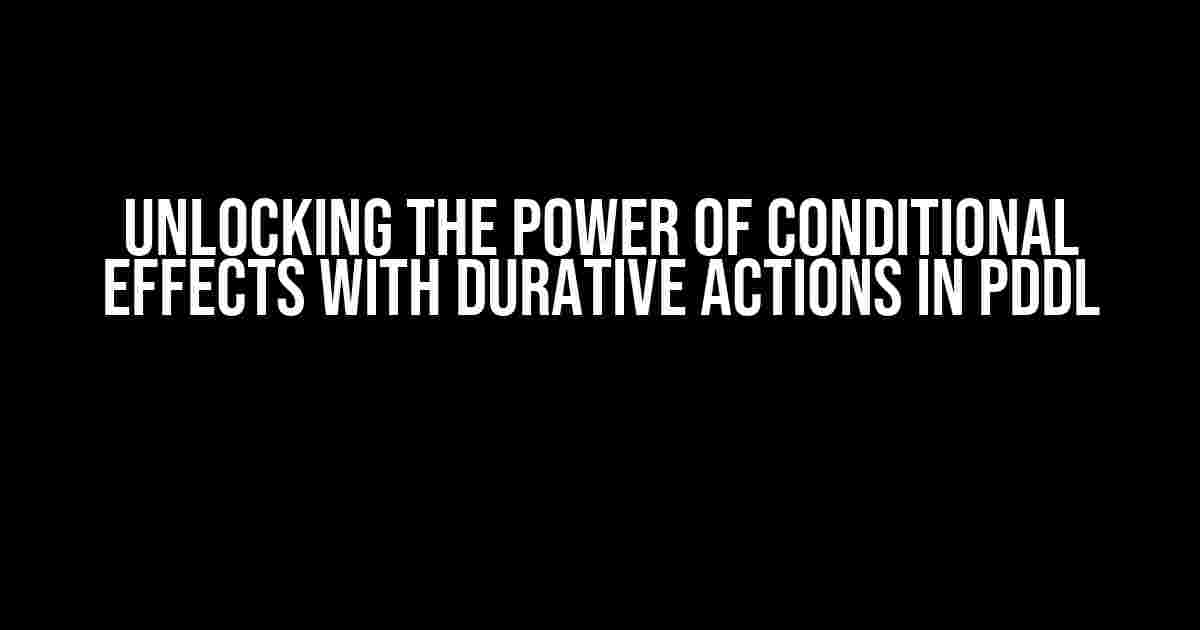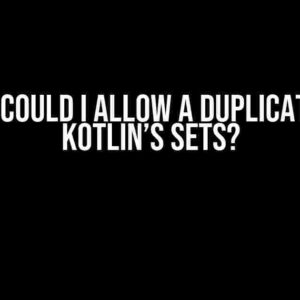Planning Domain Definition Language (PDDL) is a powerful tool for representing and solving complex planning problems. One of the most exciting features of PDDL is its ability to model conditional effects with durative actions. In this article, we’ll delve into the world of PDDL and explore how to harness the power of conditional effects with durative actions to solve even the most challenging planning problems.
What are Durative Actions?
Durative actions are a type of action in PDDL that can take a certain amount of time to complete. Unlike instantaneous actions, which occur instantaneously, durative actions have a duration and can be interrupted or affected by other events. This makes them ideal for modeling real-world scenarios where actions take time to complete.
(define (domain durative-actions)
(:actions
(move ?robot ?from ?to)
(duration 5)
(effect (and (not (at ?robot ?from))
(at ?robot ?to))
(cost 10))
)
)In the above example, the `move` action takes 5 time units to complete and has an effect that changes the location of the robot from `?from` to `?to`. The `duration` keyword specifies the duration of the action, and the `effect` keyword specifies the effect of the action.
What are Conditional Effects?
Conditional effects are a way to specify that an effect of an action only occurs if certain conditions are met. This allows for more flexibility and nuance in modeling planning problems. In PDDL, conditional effects are specified using the `when` keyword.
(define (domain conditional-effects)
(:actions
(cook ?meal)
(duration 10)
(effect (when (has-ingredients ?meal)
(cooked ?meal))
(cost 5))
)
)In the above example, the `cook` action takes 10 time units to complete and has an effect that sets the `cooked` predicate to true only if the `has-ingredients` predicate is true.
Using Conditional Effects with Durative Actions
Now that we’ve covered the basics of durative actions and conditional effects, let’s explore how to use them together. By combining these two powerful features, we can model even more complex planning problems.
(define (domain conditional-durative-actions)
(:actions
(assemble ?product)
(duration 20)
(effect (when (has-parts ?product)
(assembled ?product))
(cost 10))
(precondition (and (has-blueprint ?product)
(has-tools)))
)
)In the above example, the `assemble` action takes 20 time units to complete and has an effect that sets the `assembled` predicate to true only if the `has-parts` predicate is true. Additionally, the action has a precondition that requires both the `has-blueprint` and `has-tools` predicates to be true.
Example Scenarios
Let’s consider a few example scenarios to illustrate the power of using conditional effects with durative actions.
Scenario 1: Assembly Line
Imagine an assembly line where products are assembled in stages. Each stage takes a certain amount of time and requires specific parts and tools. We can model this scenario using durative actions with conditional effects.
(define (domain assembly-line)
(:actions
(assemble-stage-1 ?product)
(duration 10)
(effect (when (has-parts ?product)
(assembled-stage-1 ?product))
(cost 5))
(assemble-stage-2 ?product)
(duration 15)
(effect (when (and (assembled-stage-1 ?product)
(has-additional-parts ?product))
(assembled-stage-2 ?product))
(cost 10))
)
)In this scenario, the `assemble-stage-1` action takes 10 time units to complete and has an effect that sets the `assembled-stage-1` predicate to true only if the `has-parts` predicate is true. The `assemble-stage-2` action takes 15 time units to complete and has an effect that sets the `assembled-stage-2` predicate to true only if both the `assembled-stage-1` and `has-additional-parts` predicates are true.
Scenario 2: Cooking Recipe
Imagine a cooking recipe that requires specific ingredients and cooking times. We can model this scenario using durative actions with conditional effects.
(define (domain cooking-recipe)
(:actions
(prepare-ingredients ?meal)
(duration 5)
(effect (has-ingredients ?meal)
(cost 2))
(cook ?meal)
(duration 20)
(effect (when (has-ingredients ?meal)
(cooked ?meal))
(cost 10))
)
)In this scenario, the `prepare-ingredients` action takes 5 time units to complete and has an effect that sets the `has-ingredients` predicate to true. The `cook` action takes 20 time units to complete and has an effect that sets the `cooked` predicate to true only if the `has-ingredients` predicate is true.
Tips and Best Practices
Here are some tips and best practices to keep in mind when using conditional effects with durative actions in PDDL:
- Use descriptive action names and predicate names to make your domain model clear and easy to understand.
- Use the `when` keyword to specify conditional effects that only occur under certain conditions.
- Use the `duration` keyword to specify the duration of durative actions.
- Use the `precondition` keyword to specify preconditions that must be met before an action can be executed.
- Use the `effect` keyword to specify the effects of an action, including conditional effects.
- Test your domain model thoroughly to ensure it behaves as expected.
Conclusion
In this article, we’ve explored the powerful combination of conditional effects and durative actions in PDDL. By using these features together, we can model complex planning problems with nuanced and realistic scenarios. By following the tips and best practices outlined in this article, you’ll be well on your way to creating effective and efficient domain models using PDDL.
| PDDL Feature | Description |
|---|---|
| Durative Actions | Actions that take a certain amount of time to complete. |
| Conditional Effects | Effects that only occur under certain conditions. |
| When Keyword | Used to specify conditional effects. |
| Duration Keyword | Used to specify the duration of durative actions. |
With the power of conditional effects and durative actions in PDDL, you’ll be able to model even the most complex planning problems with ease. Happy planning!
Frequently Asked Question
Get the most out of using conditional effects with durative actions in PDDL with these frequently asked questions!
What is the purpose of using conditional effects with durative actions in PDDL?
Conditional effects with durative actions in PDDL allow you to model more complex and realistic planning scenarios. They enable you to specify conditions under which certain effects will occur or not occur, making your planning models more flexible and accurate.
How do I specify conditional effects with durative actions in PDDL?
You can specify conditional effects with durative actions in PDDL using the `when` keyword. For example, `(when (condition) (effect))` specifies that the effect will occur only when the condition is true.
Can I use conditional effects with durative actions to model uncertain outcomes in PDDL?
Yes, you can use conditional effects with durative actions to model uncertain outcomes in PDDL. By specifying a probability distribution over the possible outcomes, you can capture the uncertainty of the outcome and enable the planner to reason about the possibilities.
What is the difference between conditional effects and conditional goals in PDDL?
Conditional effects specify the conditions under which certain effects will occur, whereas conditional goals specify the conditions under which the goal is achieved. In other words, conditional effects focus on the outcome of an action, while conditional goals focus on the achievement of a goal.
Can I use conditional effects with durative actions to model continuous changes in PDDL?
Yes, you can use conditional effects with durative actions to model continuous changes in PDDL. By specifying the rate of change and the conditions under which it occurs, you can capture the continuous evolution of the system over time.


